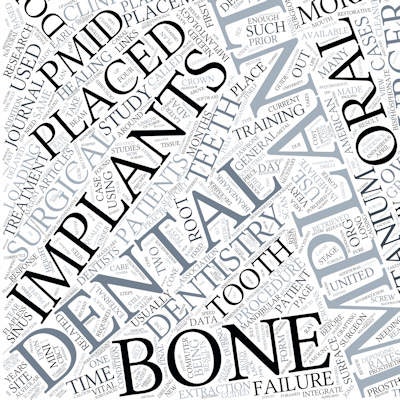
How successful are dental implants inserted with low torque? Do they provide sufficient stability for early-stage loading? To find out, researchers retrospectively examined short-term outcomes of treating edentulous maxillary arches with four implants supporting an immediate fixed prosthesis.
They analyzed results from 83 patients who received 332 implants at one clinic using the All-on-4 treatment protocol concept (Nobel Biocare). The results indicated that implant success with lower insertion torque was comparable to implantation with higher insertion torque and did not lead to compromised outcomes over four years. The group published their findings in the International Journal of Oral & Maxillofacial Surgery (May 4, 2018).
"Cumulative implant success was high, and marginal bone loss was low," wrote the study authors, led by Paulo Maló, DDS, PhD, president and CEO of the Maló Clinic in Lisbon, Portugal.
How low can you go?
Placing immediate-function implants in which the dental implant, abutment, and fixed prostheses are provided on the same day requires achieving an implant insertion torque greater than 35 Newton cm (Ncm), according to previous studies. Published literature indicates that placement of implants using low insertion torque is a possible risk factor for implant failure.
Nevertheless, higher insertion torque above 35 Ncm is not always possible in low-density bone, and loading is discouraged in such cases until after a healing period of four to six months, the authors noted.
Due to the lack of research on implants inserted using this technique, the researchers retrospectively conducted the current study to investigate outcomes of implants inserted with less than 30 Ncm of torque for full-arch maxillary rehabilitation using the All-on-4 concept.
“Cumulative implant success was high, and marginal bone loss was low.”
With this protocol, patients received four implants at once (NobelSpeedy Groovy, Nobel Biocare) between the anterior walls of both maxillary sinuses -- two axial anterior and two tilted posterior implants -- which were loaded on the same day with immediate-function high-density acrylic resin and acrylic resin crowns.
The study included all patients who received any implant using the All-on-4 technique with torque less than 30 Ncm at the Maló Clinic from 2010 through 2013. They excluded anyone who was currently undergoing chemotherapy or radiotherapy. The researchers followed a total of 83 patients (69 females) for an average of 30 months, with 21 patients who underwent examination at four years after insertion. In total, the patients received 332 implants, of which 120 implants were placed with less than 30 Ncm and 212 with 30 Ncm or greater.
Under local anesthesia, patients underwent surgery and prosthetic restoration performed by the same team. A surgical guide (All-on-4 Guide, Nobel Biocare) helped with implant insertion positioning in relation to the opposing jaw and the angulation of the posterior implants.
After at least six months and several follow-up visits, patients received definitive full-arch prostheses of metal-ceramic or metal-acrylic resin of the same type they had before according to their preference.
The study's primary outcome measures were implant success and prosthetic survival at one year of follow-up. The investigators evaluated implant success using the following criteria:
- Fulfilled function as support for reconstruction
- Stable when individually and manually tested
- No signs of infection
- No radiolucent areas around the implants
- Good aesthetic outcome
- Allowed construction of an implant-supported fixed prosthesis, which provided patient comfort and allowed for maintenance of good hygiene
The investigators considered implants not fulfilling these criteria to have survived and those that were removed failures. As a secondary outcome, they evaluated marginal bone loss using periapical radiographs taken on the day of surgery and at one year of function.
The researchers reported a cumulative implant success rate of 97.5%. The success rates and margin bone loss at the different torque levels are shown in the table below.
| Success of dental implants by torque insertion level | ||
| 30 Ncm or greater | Less than 30 Ncm | |
| Success rate | 97.5% | 98.3% |
| Marginal bone loss | 1.39 mm | 1.14 mm |
A lower insertion torque threshold did not compromise implant success or functional loading, the study authors reported.
"The present study found that a lower insertion torque threshold (less than 30 Ncm) did not compromise the survival outcome or functional loading, suggesting that the risk of implant failure in immediately loaded implants inserted in the maxilla may not be dependent only on the insertion torque or bone density," they wrote.
Successful implantation
The single-center retrospective design and short-term follow-up are limitations of the study, according to the authors. The fact that the majority of patients received implants using both high and low insertion torque may have positively influenced the results, they added.
Future research should study the outcomes of immediate loading with different implant designs and low insertion torque and include longer outcomes, the authors suggested. Nevertheless, their current results demonstrated the success of lower insertion torques within the parameters they studied.
"Implants inserted with less than 30 Ncm of torque in an All-on-4 arrangement have similar short-term success outcomes and less marginal bone loss compared to implants inserted with 30 Ncm or greater of torque," they concluded.


















